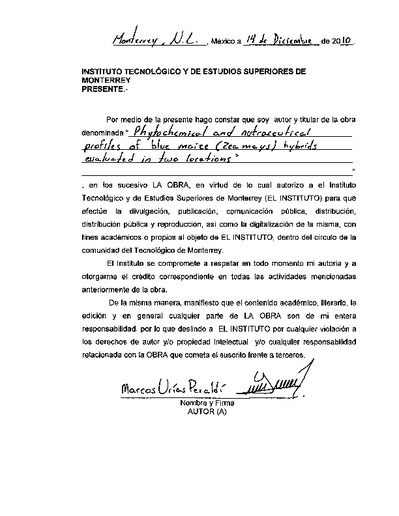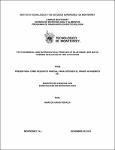| dc.contributor.advisor | Serna Saldívar, Sergio Othón | |
| dc.contributor.advisor | García Lara, Silverio | |
| dc.creator | Urías Peradlí, Marcos | |
| dc.date.accessioned | 2015-08-17T10:33:16Z | en |
| dc.date.available | 2015-08-17T10:33:16Z | en |
| dc.date.issued | 2010-12-01 | |
| dc.identifier.uri | http://hdl.handle.net/11285/569946 | en |
| dc.description.abstract | Recent years have seen an increased interest in blue maize (Zea mays) due to its proven nutraceutical properties. In recent times blue maize hybrids have been developed through a landrace starting point and by genetic improvement. These hybrids are being evaluated for their environmental stability and agronomic profile. With this objective, 25 promising
hybrid blue maize crosses were selected from the improvement program at INIFAP-Bajío and planted in 2 contrasting environments located in the Bajío area and Morelia.
The objective of this work was to evaluate the phytochemical and nutraceutical profiles
of these hybrids and to select those with the best features. An initial bulk analysis was
elaborated to elucidate any significant differences between both locations. Free and
bound phenolic acids were evaluated using the Folin-Ciocalteu method as were their
antioxidant capacity using the Oxygen Radical Absorbance Capacity (ORAC) method. Bound
ferulic acid content was determined by High Pressure Liquid Chromatography (HPLC) and
total monomeric anthocyanin content was determined by the pH differential method. Soluble
carbohydrates, protein methods and biophysical properties like kernel color and endosperm
texture were also determined. The results indicate a significant difference among the 25
genotypes evaluated. With a number of genotypes having free and bound phenolic acids content
higher than those previously reported; their respective antioxidant capacities also showed
high levels. Bound phenolic acid showed a significant difference between environments
whereas anthocyanins were not affected by the environment. Soluble carbohydrate and
soluble protein determination confirmed that white maize conversion retains key
phytochemical properties. Results show a surprising correlation between chroma and
anthocyanin content as well as for other kernel color measurements. Overall, the 25 hybrid
blue maize genotypes evaluated were little influenced by the environment and retained high
levels of health promoting phytochemicals and nutraceutical activity. A number of
genotypes exhibited high phytochemical and nutraceutical profiles that can be used as
a basis for crop improvement in further studies involving breeding blue maize. Especially
genotype 22 which showed stability among regions and across most phytochemical traits, having
high anthocyanin content, ferulic acid and antioxidant capacity. | |
| dc.language | eng | |
| dc.publisher | Instituto Tecnológico y de Estudios Superiores de Monterrey | |
| dc.rights | info:eu-repo/semantics/openAccess | |
| dc.rights.uri | http://creativecommons.org/licenses/by-nc-nd/4.0 | * |
| dc.subject.classification | Area::CIENCIAS AGROPECUARIAS Y BIOTECNOLOGÍA::CIENCIAS AGRARIAS::AGRONOMÍA::GENÉTICA VEGETAL | es_Mx |
| dc.title | Phytochemical and Nutraceutical Profiles of Blue Maize (Zea Mays) Hybrids Evaluated in Two Locations-Edición Única | en |
| dc.type | Tesis de maestría | |
| dc.contributor.department | Tecnológico de Monterrey, Campus Monterrey | en |
| dc.contributor.committeemember | Gutiérrez Uribe, Janet Alejandra | |
| dc.contributor.committeemember | Ramos Parra, Perla Azucena | |
| refterms.dateFOA | 2018-03-06T16:12:05Z | |
| refterms.dateFOA | 2018-03-06T16:12:05Z | |
| dc.identificator | Campo||6||31||3103||241714 | |



